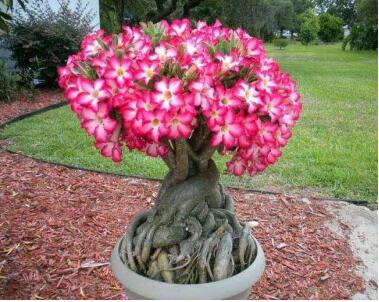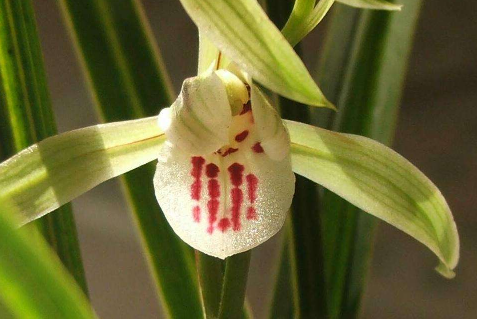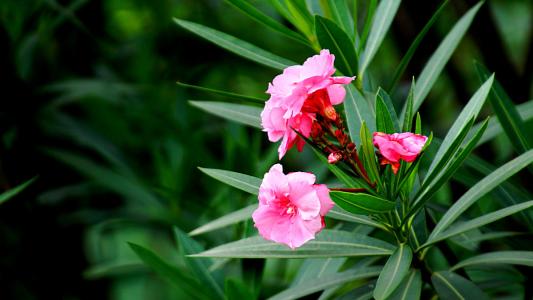2. Matters needing attention in breeding desert roses
1. Watering
When watering, be sure to make sure that the surface of the soil is dry and re-watered to prevent excessive watering.
2. Beware of poisoning
We should keep in mind that this plant is poisonous. When raising it, don't eat it by mistake to prevent poisoning.
3. Pruning
Many people ignore the pruning of desert roses, but regular pruning of this plant can maintain the shape of desert roses. Desert rose can survive in a harsh environment, its flower language is to love you unswervingly.

After introducing the breeding methods and matters needing attention, we can again understand the medicinal value of desert roses. Desert roses are not only beautiful, but also outstanding in terms of medicinal efficacy. Let's take a closer look at the medicinal uses of desert roses.
Culture methods and matters needing attention of Desert Rose
First understand the desert rose habits, like high temperature, drought, sunny climate, like calcium-rich, loose and breathable, well-drained sandy loam, not resistant to shade, avoid waterlogging, avoid thick fertilizer and raw fertilizer, afraid of cold, the suitable temperature for growth is 25-30 ℃. Desert rose is a kind of plant with great ornamental value, which is loved by many people. The breeding methods and matters needing attention of desert rose are introduced below.
Culture methods of Desert Rose
1. Soil: desert rose does not require high performance of soil, but it needs loose and well-drained soil, which can help desert rose grow better, and its culture mechanism can be configured with coarse sand, rotten leaves, limestone grains and vermiculite. at the same time, it is good to add some ternary compound fertilizer as base fertilizer.
2, sunshine: desert rose's favorite sunshine, its growth process can let the sun shine directly, at the same time can regularly turn the basin, so as to ensure the beauty of the branches.
3. Watering: desert roses like dry environment. Watering pursues the principle of dry and wet. Desert roses grow in summer. As long as it has enough moisture, it can be watered every 1-2 days. Less watering is needed in winter.
4. Fertilization: what desert roses do not like is great joy. Generally, during their growing period, it is mainly nitrogen fertilizer, supplemented by phosphorus and potassium fertilizer, with a ratio of about 2: 1: 1. Generally, thin compound liquid fertilizer is applied every 10 days.
5. Pruning: usually the desert rose can be pruned, which can effectively ensure the softness and ornamental of the desert rose branch, and at the same time, the branch can be shaped to maintain the ideal plant type of the desert rose.
6. Pest control: if there is harm to leaf spot disease, it can be sprayed with 500 times of 50% topiramine wettable powder. Insect pests are harmful to shell insects and armyworms, which are sprayed with 1000 times of 50% fenitrothion EC. The main pest is scale insects. When it is serious, it will cause all the leaves to fall off, plant growth point necrosis, and even plant death. Family cultivation should pay attention to observation, as soon as found that immediately with a cotton swab dipped in water to erase it.
Matters needing attention in desert rose culture
1. The leaf spot disease of desert rose is serious, which can cause a large number of leaves to fall off. It can be controlled with 25% carbendazim wettable powder and 50% topiramate 1000 times.
2. The main pest of desert rose is shell insect. When it is serious, it will cause all the leaves to fall off, plant growth point necrosis, and even plant death. Family cultivation should pay attention to observation, as soon as found that immediately with a cotton swab dipped in water to erase it. It can also be sprayed twice with 40% omethoate EC 1000-2000 times or 50% fenitrothion EC 1000 times during the spawning and incubation period.
Desert rose value 1. Ornamental value
No matter the flowers, leaves, stems, or its shape, are elegant and chic, natural and generous, unique style, especially suitable for family interior and balcony decoration. In full bloom, most of the leaves fall off, the flowers are all over the branches, and the posture is graceful.
2. Horticultural design
Desert rose plant is short, tree-shaped simple and vigorous, and the rhizome is as fat as a wine bottle. It blossoms twice every year from April to May and from September to October, bright red and beautiful, shaped like a trumpet, very chic, and deeply loved by people. Southern planting layout of a small courtyard, simple and dignified, natural and generous. Potted ornamental, decorated indoor, balcony unique.
Culture methods and matters needing attention of Desert Rose when do Desert Rose bloom
Desert rose plant is short, tree-shaped simple and vigorous, and the rhizome is as fat as a wine bottle. It blossoms twice every year from April to May and from September to October, potted and ornamental, decorating the interior and balcony with a unique style. So, let's take a look at the breeding methods and precautions of desert roses.
Morphological characteristics of desert rose:
Succulent shrubs or small trees, up to 4.5 m; trunk swollen. Leaves alternate, apical, Obovate to elliptic, 15cm long, entire, apex obtuse and mucronate, fleshy, subsessile. Corolla funnelform, pubescent outside, 5-lobed, ca. 5cm in diam., outer margin red to pink, middle color light, lobes margin undulate; terminal corymb.
Desert roses are shaped like trumpets, rose-red and very gorgeous. Umbels are clumps of brilliant flowers that blossom throughout the year. The desert rose is named because its origin is close to the desert and as red as a rose. Desert rose simple leaves alternate, Obovate, tip acute, 8 cm ~ 10 cm long, 2 cm ~ 4 cm wide, leathery, glossy, dark green ventral, grayish green abaxially, entire. Raceme, terminal, with more than 10 flowers, trumpet-shaped, 6 cm ~ 8 cm long; Corolla 5-lobed, with rose, pink, white and complex colors. The flowering period of desert rose is from May to December, and the flowers are red, rose, pink, white and so on. It is easy to bear fruit in greenhouse cultivation in the south. The seeds are white pilose, which can help them spread in flight. Note:
Desert roses are certainly toxic, but their milk toxicity is the strongest, but desert roses can be maintained indoors, as long as they are not eaten by mistake.
Growth habits of desert roses:
Like high temperature, drought, sunny climate environment, like calcium-rich, loose and breathable sandy loam, do not tolerate shade, avoid waterlogging, avoid thick fertilizer and raw fertilizer, fear cold, and grow at a suitable temperature of 25-30 ℃.
Summer can be placed outside in a sunny place without shade and fully watered to keep the soil moist, but not stagnant water. Controlled watering is needed in winter, and the overwintering temperature is maintained above 10 ℃ to make the fallen leaves dormant. In cultivation, organic fertilizer should be applied 2 to 3 times a year.
Propagation can choose 1-2-year-old branches of about 10 cm in summer to be cut off, cut in the sand bed after the incision is slightly dry, and take root in 3 to 4 weeks. It can also be propagated by high-altitude striping in summer. If the seeds can be collected, they can also be sown and propagated.
Culture methods and matters needing attention of desert roses-culture methods:
First, desert roses are mainly propagated by sowing and cutting. It is better to sow in spring, and the method of spot sowing is used to facilitate the management after emergence. Be sure to disinfect the substrate before sowing. After emergence, pay attention to the substrate in the sowing plate should not be too wet, otherwise the roots may rot and cause a large number of seedlings to die. It is better to cut in the vigorous growing season. Cut the branch into about 10 cm, soak the lower end in water and dilute the mucus at the cut to prevent cementation from affecting the hairy root. It can be inserted into the sand bed or directly into the sterilized cultivation substrate, and it can take root in about 15-30 days. In reproduction, it is recommended to use sowing method to propagate, so that the plant rhizome can naturally expand to form a good plant shape. Cutting seedlings can not, but also greatly reduce the ornamental value.
Second, in addition, in the cultivation, the desert rose branches are easy to grow, which affects the beautiful plant shape, so the plant shape can be changed by grafting. All the branches can be cut off according to a certain shape at a certain height of the plant, and then the upper end of the cut branches can be grafted by split grafting. The plant shape of the grafted plant is beautiful, and the flower branches are compact and ornamental after flowering.
Third, desert roses are more resistant to drought, not too much water each time, if more water, it is easy to cause root rot, at the same time, the branches are too long, it is more troublesome to prune. When it is hot in summer, it can be watered according to the soil condition. It is usually watered once every two or three days, and no water can be accumulated in the basin. As the temperature drops in winter, desert roses also enter a semi-dormant period, so properly control watering, keep the soil dry and water once a week. Proper drought is very beneficial to the growth of desert roses. The leaves of winter desert roses fall off gradually when they enter the dormant period, which is normal, so there is no need to be nervous about it. ]
Fourth, desert roses prefer phosphorus and potassium fertilizer, which is usually replenished once a month or so. During the peak growth period in summer, sufficient fertilizer and water are needed so that the flowers can be luxuriant and bright. In addition, combined with the annual basin change, you can also properly apply some long-term base fertilizer in the basin, such as rotten bean cake, bone meal and so on. Desert roses prefer phosphorus and potassium fertilizer and are usually replenished once a month or so. During the peak growth period in summer, sufficient fertilizer and water are needed so that the flowers can be luxuriant and bright. In addition, combined with the annual basin change, you can also properly apply some long-term base fertilizer in the basin, such as rotten bean cake, bone meal and so on.
Fifth, the pruning of desert roses is also very important. If you do not pay attention to the usual pruning and let it grow, it is easy to lose its ornamental value. After flowering is the best time for pruning, you can make a choice according to your personal preference. Note: if you have more branches, you will blossom more. If you want to get more flowers, you must find ways to keep more ramets.
Culture methods and precautions of desert roses:
1. The leaf spot disease of desert rose is serious, which can cause a large number of leaves to fall off. It can be controlled with 25% carbendazim wettable powder and 50% topiramate 1000 times.
2. The main pest of desert rose is shell insect. When it is serious, it will cause all the leaves to fall off, plant growth point necrosis, and even plant death. Family cultivation should pay attention to observation, as soon as found that immediately with a cotton swab dipped in water to erase it. It can also be sprayed twice with 40% omethoate EC 1000-2000 times or 50% fenitrothion EC 1000 times during the spawning and incubation period. [attention should be paid to the safety of drug use when carrying out pest control. ]
3. Key points of maintenance: [good sunshine], [temperature of about 30 ℃], [watering of basin soil after drying], [proper fertilization in spring and summer rainy season], [dropping basin soil and changing basin at appropriate time]
- Prev

Matters needing attention in the Culture of Cold Orchid
1. Cold orchid leaves slender, many stomata, thin leaves and air contact surface is large, fresh environment can promote plant growth well. The farmed cold orchid medicine is placed away from the oil fume and the air outlet of the air conditioner, and the leaves can be often washed with clean water. two。 Seedling division usually begins in August, which is helpful to inhibit the formation of germination.
- Next

Conservation measures and precautions of oleander
1, pruning often pruning oleander can not only maintain the beauty of the plant shape, but also promote the growth of oleander, flowers more beautiful. 2. The root system of oleander is relatively developed. If it is not managed, it will affect the growth of oleander. Therefore, the root of oleander should be thinned.
Related
- Fuxing push coffee new agricultural production and marketing class: lack of small-scale processing plants
- Jujube rice field leisure farm deep ploughing Yilan for five years to create a space for organic food and play
- Nongyu Farm-A trial of organic papaya for brave women with advanced technology
- Four points for attention in the prevention and control of diseases and insect pests of edible fungi
- How to add nutrient solution to Edible Fungi
- Is there any good way to control edible fungus mites?
- Open Inoculation Technology of Edible Fungi
- Is there any clever way to use fertilizer for edible fungus in winter?
- What agents are used to kill the pathogens of edible fungi in the mushroom shed?
- Rapid drying of Edible Fungi

